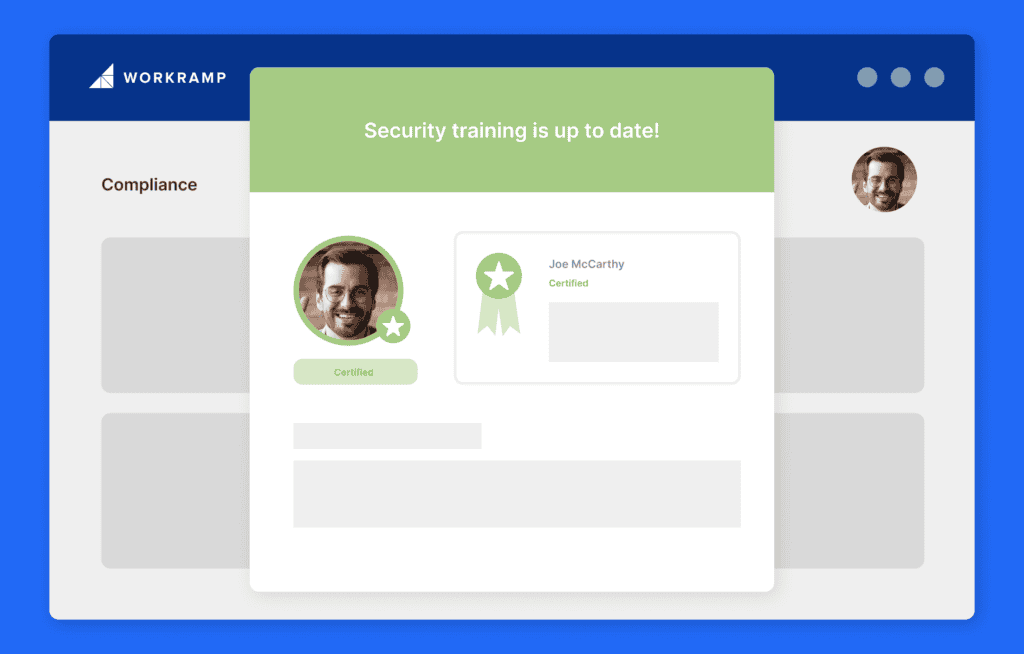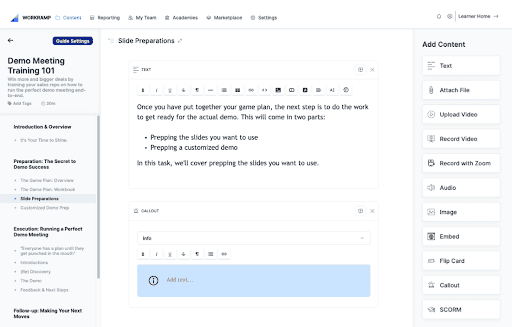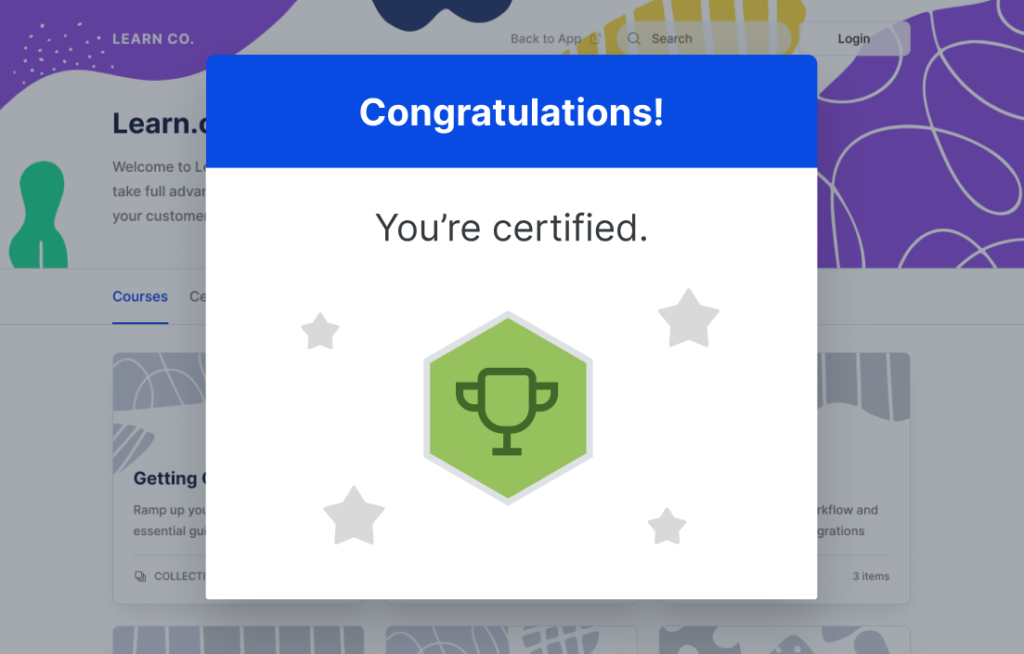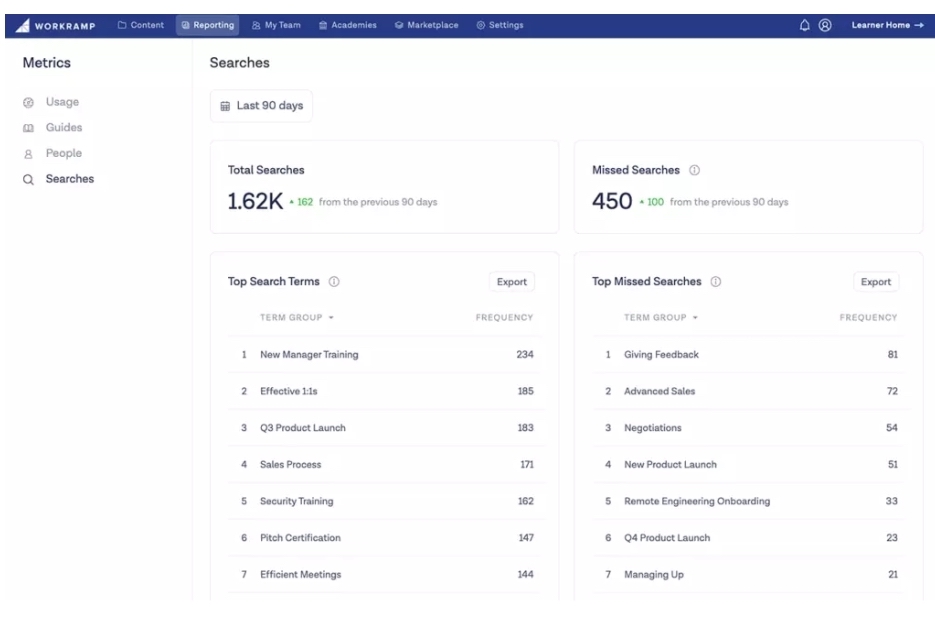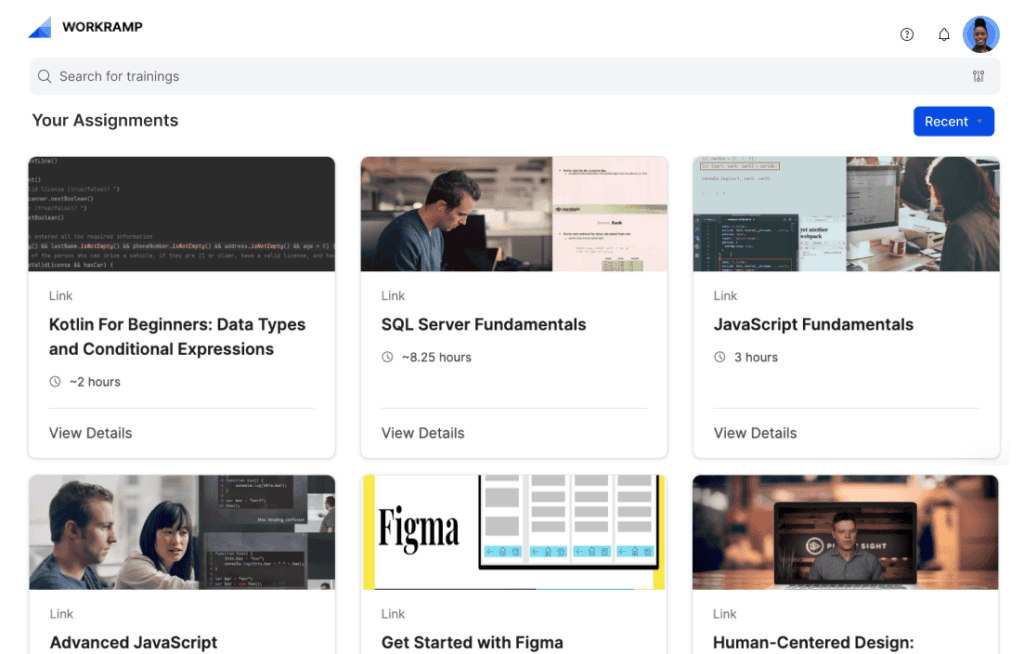Healthcare LMS: Use Cases, Features, & Examples
Elise Dopson | WorkRamp Contributor
View bioLearning Tips Straight to Your Inbox
In this post:
Training opportunities aren’t “nice to have” in a heavily regulated industry like healthcare—they’re crucial to operating an efficient organization. But there’s a gap between what healthcare providers offer and the experience expected by employees.
Studies have shown that just 29 percent of healthcare employees are “very satisfied” with their current career advancement opportunities in their organization—likely a driving force behind the fact that workers in healthcare roles at nursing facilities have one of the highest staff turnover rates.
A learning management system (LMS) can help you retain staff and operate a more effective healthcare business that remains compliant with regulations and laws. It’ll become easy for facilitators to develop new content, and for employees to enroll in learning courses when you have a platform to manage all aspects of professional development.
If you’re unsure of which features to look for or how to get the most use out of your healthcare LMS, this guide will help. We’ll share the different use cases and recommend three of the best healthcare LMSs to consider.
What is a healthcare LMS?
A healthcare LMS is a specialist software that helps healthcare providers manage their learning programs. It can house various types of training materials—be that webinars, podcasts, or online courses—which employees can access using their own devices.
Healthcare LMSs are essential if your business is growing and you want to build a culture of learning within the organization. It eliminates the need for resource-intensive in-person training sessions and helps trainers make better decisions about their training programs since you can rely on historical data about learner performance as opposed to gut instinct (that isn’t always accurate).
Healthcare LMS use cases
Now we know what a healthcare LMS is, let’s dive further into the use cases with examples of how you might use one.
Continuing medical education
Continuing medical education (CME) is a required part of many accredited or qualified healthcare roles. It shows an ongoing commitment to learning and ensures that each employee is up to date with the latest research.
CME courses can also come with credits—points that healthcare employees must accumulate in order to renew their licenses or accreditations. Your healthcare LMS can award these credits based on the training materials that each employee has interacted with through the platform, or their pass mark for the end-of-module learning assessments.
Training and onboarding new employees
A healthcare LMS gives you a centralized place to store your learning materials so that when you onboard new employees, the learning experience they get is consistent.
The best learning management systems also allow you to build personalized learning paths based on each employee’s existing skill set, job title, and experience. If you’re onboarding administrative assistants and pediatric clinicians, for example, both could get your company culture and values training, but different modules based on their job roles.
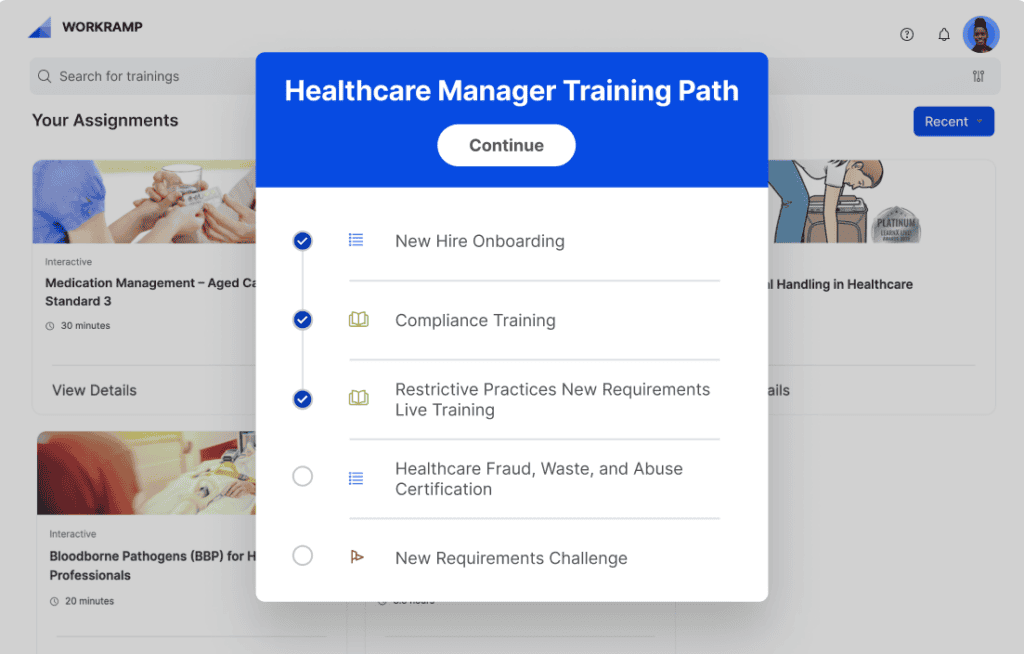
Clinical skills training
A healthcare LMS is an essential tool for clinical skills training, helping you train staff on the latest medical techniques, procedures, and best practices in a controlled and consistent manner.
To make this possible for your organization, choose a healthcare LMS that supports interactive training like simulations or supervised role-playing. This offers a safe space for employees to perform surgical procedures or suggest potential treatments in a safe environment without putting your patient’s health at risk.
Compliance training
Legal regulation surrounds healthcare to protect patients. Failure to meet these regulations could result in hefty fines or damages, hence why most providers use a healthcare LMS to ensure they’re compliant with appropriate laws, rules, or regulations.
(Non-compliance can be very expensive to contend with; the average annual cost a company will spend on non-compliance issues is $14.8 million.)
Use your healthcare LMS as a place to offer consistent compliance training on topics like:
- Patient Privacy
- Healthcare standards
- Occupational health and safety protocols (including mental health)
- Cybersecurity risks
The biggest advantage of using a healthcare LMS over manual training is that you can help employees renew annual certifications when they’re due—which is difficult to do when managing a large team. Not everyone’s certifications will be due for renewal at the same time.
The LMS tracks each employee’s compliance requirements, automatically assigns courses, and ensures timely completion so that your business isn’t left exposed by non-compliance.
Healthcare IT training
Healthcare teams likely rely on technology in their daily roles—whether they’re recording patient notes in an electronic healthcare record (EHR) system or conducting remote consultations. Your healthcare LMS can standardize this IT training and ensure that everyone sticks to the same best practices when using software.
Professional development
Most employees are invested in their own personal development, turning to their employers for guidance when building their skills and staying up to date with industry trends. The healthcare industry is no different.
Failing to offer learning opportunities—particularly those delivered in the format your learners best engage with—can improve retention. Some 39 percent of employees would leave their current role to work for a company that offers better learning programs, but with a healthcare LMS, you can have an “always on” approach to learning. Employees can access training materials whenever they see fit.
Quality improvement initiatives
The primary goal of healthcare is to improve patient health and safety. Quality improvement helps providers achieve that goal by making steady, gradual improvements to their services—whether that’s improving operational efficiency, ensuring compliance with regulatory standards, or following the latest protocols.
For example: the healthcare LMS could assign targeted training to address specific quality gaps, such as reducing patient readmission rates or improving patient safety practices.
Remote learning and telemedicine
Remote learning programs have become the norm since the pandemic forced everyone to find alternative ways to work from home.
With a healthcare LMS, employees can access your online courses anytime without disrupting their clinical schedules. New healthcare staff can also complete their training at home before stepping into the clinical environment.
Your healthcare LMS can also train employees on how to deliver patient care through telemedicine practices like virtual appointments, patient monitoring, or consultations. This frees up your employees’ time—oftentimes helping them see more patients than they would in a traditional clinic setting.
Interprofessional education
Interprofessional education (IPE) happens when students or professionals from different healthcare disciplines learn together to improve their collaboration skills and enhance the quality of patient care.
The goal of IPE is to introduce teamwork into healthcare education, and your LMS is the perfect home for it to take place. Employees from various fields—such as medicine, nursing, pharmacy, and social work—can collaborate on learning materials, mentor each other, and ultimately provide better patient outcomes within the learning platform.
Patient education
A healthcare LMS isn’t just useful when you’re providing internal training. You can use the same platform to teach and educate customers outside the facility and in their own time, alleviating pressure on your administrative teams to answer patient questions.
We can see this in action with a nursing team that’s explaining how patients can administer their own injections. The nurse gives a quick demonstration while the patient is in the clinic, but the process is intimidating—especially if the patient has never done it before. The patient leaves the clinic confused and calls back later that day for clarification.
With a healthcare LMS, however, you could upload a prerecorded demonstration video to the online learning portal. The nurse provides a printed leaflet with written injections and a QR code to access the video. Now, the patient can watch the video as they do the injection, pausing at each step to follow along.
Features to look for in a healthcare LMS
Not all healthcare LMSes are created equal. Here are 12 of the most important features to look for when shortlisting different providers.
HIPAA compliance
Health Insurance Portability and Accountability Act, abbreviated to HIPAA, is a set of regulations that protect patient’s health information. It states that all patient data should be treated confidentially and secured in a HIPAA-compliant platform—including your healthcare LMS.
Let’s put that into practice and say you’re developing a training module that teaches clinical staff how to handle upset patients who’ve just received a life-changing diagnosis. You use call recordings from previous interactions as a way to educate staff on how to navigate the conversation empathetically. The platform you’re using now needs to be HIPAA compliant as it contains protected patient information.
Content management
Your healthcare LMS is where you’ll be training all team members, including those in non-clinical roles like administration, finance, or HR. That’s not to say you need different platforms to host each type of content. The right LMS will have content management features that make it easy to upload, assign, and access content that learners need.
The best LMSes have advanced search capabilities and tagging tools to surface learning materials when learners look for them. Administrators, for example, might need to consult your cybersecurity course when they’re suspicious of an email. Being able to search for this topic is much easier than asking a colleague and waiting for a response.
It’s even better if your healthcare LMS has artificial intelligence features within its learning content management system (LCMS). WorkRamp, for example, has:
- AI Assist: Brainstorm training ideas, outline a training module, or generate images with this generative AI feature.
- AI Practice: Launch AI-driven role-play bots into your healthcare LMS to help medical teams experience real-life situations, without putting patients at risk.
User role management
Not everyone in your organization will use the healthcare LMS in the same way or for the same purpose. You’ll might have:
- Stakeholders who want to view LMS analytics
- Training facilitators who upload training materials and organize the library
- Course authors who are collaborating to produce a piece of training content
- Students who enroll in your learning and development programs
When evaluating your options, check whether your healthcare LMS can restrict access to certain materials based on their job roles. A doctor may have access to training that includes patient data for case study purposes, for example, while receptionists and administrators don’t. This helps maintain patient privacy and protect your customers’ data.
Collaboration and communication tools
With a healthcare LMS that supports native collaboration, teams can work together to produce learning materials that are fit for purpose.
Communication tools—be they live chat, video conferencing, or company-wide announcements—also eliminate the need for multiple platforms, each with its own login credentials and monthly subscriptions. Learners can contact course creators with any questions directly within the platform.
Mobile compatibility
The mobile learning market is projected to reach $155.81 billion by 2026. Demonstrating students’ preferences to learn from their mobile devices, it’s important to choose a healthcare LMS that’s not only mobile-compatible but has a positive learning experience for on-the-go learners.
Mobile-friendly LMSes have the added benefit of encouraging microlearning. Students can quickly sign into the app during a quiet break and complete refresher training in as little as five minutes.

Say your physicians are dealing with an emergency and need to review your latest protocols during an emergency. Instead of searching for a computer and signing into their account, they could take their mobile device out of their pocket, open their healthcare LMS app, and locate the protocol. It’d save time (and potentially the patient’s life).
Interoperability with existing systems
You shouldn’t need to overhaul your existing technology infrastructure when implementing a new learning management system. Simply making sure that your new software integrates with the tools you’re already using can save time and money, while improving data consistency. No copy and pasting means the data you’re working from isn’t affected by human error.
Before committing to a new healthcare LMS, check that it integrates with tools like:
- Electronic Health Record (EHR) systems
- Telemedicine platforms
- HR and payroll software
- Staff scheduling and workforce management software
- Team collaboration tools like Microsoft Teams or Slack
Let’s put that into practice and say you’re training a team of nurses who use an EHR system to log patient activity. Your healthcare LMS can tell the EHR system that the individual’s annual compliance training is up to date, and they’re therefore certified to perform a procedure.
Certification and compliance tracking
Healthcare certifications often need renewing each year, but when you’re training a large team, each with its own start dates, it can be difficult to monitor whose certification needs renewing when. This lack of insight, often provided by manual methods like spreadsheets, could cause your team to work without the appropriate training.
Check that your healthcare LMS supports automated certifications and compliance tracking. In practical terms, that might mean automatic reminders that email both learners and training facilitators one month before an annual certification is about to expire.
This feature is arguably the most important to consider when evaluating your LMS options because it provides a central record of compliance. Should your organization get audited by a regulatory body, you’ll have evidence to show that your certifications are valid and up-to-date.
Reporting and analytics
Choosing a healthcare LMS with robust reporting and analytics tools is vital for monitoring, evaluating, and improving both individual and organizational performance. Training facilitators can access analytics to determine whether training materials are meeting their intended objectives, track compliance, and prioritize future learning materials.
For example, after analyzing training reports inside their healthcare LMS, a clinic discovers that nurses need additional training on updating patient records. They’re failing the end-of-module quiz; the module itself has one of the lowest learner satisfaction scores.
Now that you have this data, you can prioritize updating it. That might mean adding a webinar, a role-playing simulation, or a question-and-answer session with a sales representative from the software provider itself. Each new material caters to a different learning style.
Assessment and evaluation tools
Regular evaluation is the only way to know whether your healthcare team is meeting performance standards, complying with regulations, and retaining knowledge taught in your learning content—so it’s critical to evaluate any shortlisted providers’ assessment capabilities when comparing healthcare LMSes.
We can see this in action with a training module that educates pharmacists on new drug interactions. You could build an end-of-module quiz that asks them questions related to the webinar which automatically grades them and provides feedback. Only when they pass the course can you update their certification.
Security and data privacy
Whether it’s a fraudster gaining unauthorized access to your training materials or eavesdroppers picking up on data being passed from the platform to another tool, it’s important to choose a healthcare LMS that takes privacy seriously. Failing to do so could leave you liable for damages and ruin your facility’s reputation.
HIPAA compliance aside, check that your healthcare LMS offers security and data protection features like:
- Audit trails
- SOC 2 Type II compliance
- SSL certificates
- Two-factor authentication
- Encrypted data exchange
Multilingual support
There isn’t much use in offering L&D content if your healthcare teams can’t access it. When your platform offers multilingual support, however, you can ensure that all staff—regardless of their native language or background—can absorb the information you’re teaching in the way they prefer.
The same concept applies if you’re using your healthcare LMS for patient education. Help non-native speakers absorb your training materials by translating them into another language. (The best LMSes have AI features to take care of this task.)
Best healthcare LMS platforms
Ready to choose a healthcare LMS with these essential features? No matter the use case, here are three of the best healthcare LMS platforms to shortlist.
1. WorkRamp
WorkRamp is an all-in-one learning management system that helps healthcare professionals manage their L&D programs from end to end.
Whether you’re training patients or internal teams, WorkRamp lets you:
- Create a customizable online academy for education
- Build upon prebuilt compliance content to save time and keep training up to date
- Offer personalized learning paths based on an employee’s job role, skills, or experience
- Track learner progress with LMS analytics and reporting
- Integrate your LMS with apps like Zapier, Slack, and Zoom
Take it from Tenaje Calloway, Manager of Clinical Implementations at Blink Device Company, who says: “Our device, TwitchView, has a unique clinical focus, and implementing it comes with practice and workflow changes, so offering educational resources allows us to support clinicians with successful implementation, ongoing utilization, and refreshers for our early adopters.”
The company leaned on WorkRamp’s healthcare LMS to make this possible. Tenaje adds: “Leaning into customer education with WorkRamp has been an absolute game-changer.”
2. Relias Platform
Relias is a LMS software that’s purposely built for healthcare organizations. Aside from creating your own training materials, Relias can help you recruit new employees and maintain compliance. It also offers a community of in-house clinicians that you can collaborate with when producing new content inside the healthcare LMS.
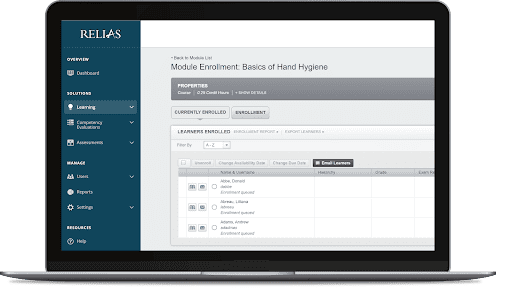
3. CareAcademy
CareAcademy’s healthcare LMS is best suited for caregivers, whether that’s in a hospice, home care agency, or assisted living facility. It offers on-demand training through its online academy or mobile app and helps organizations stay compliant with prebuilt courses on topics like mental illness care, job-related stress, and maintaining a clean and healthy environment.
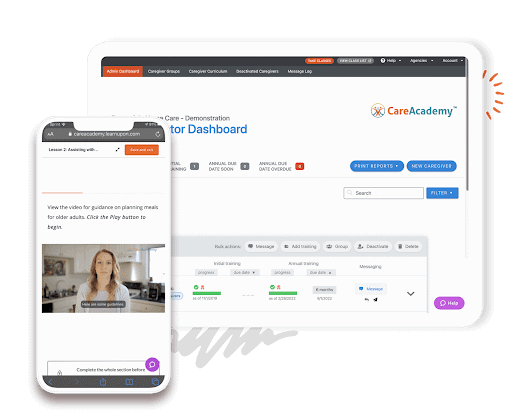
Choose the best healthcare LMS
A healthcare LMS is the most effective way to manage the learning and development opportunities you’re providing to employees. Students get a central repository of learning content that’s accessible on any device, and you can rest assured knowing that your compliance requirements are being met with regular reminders and certifications.
WorkRamp’s healthcare LMS helps you operate internal and external training programs for your organization. Contact us today to schedule a free, personalized demo.
Complete the form for a custom demo.
Recent Posts
- How AI is Transforming Sales Coaching April 11, 2025
- Remote Employee Onboarding in 2025: A 5-Step Framework April 9, 2025
- Customer Training Programs: How to Build a Scalable Strategy April 3, 2025
- WorkRamp Launches the Embedded Learning Cloud to Power White-Labeled Learning Capabilities April 2, 2025
- 7 AI-Powered Learning Tools Reshaping Employee Training March 28, 2025
Elise Dopson
WorkRamp ContributorElise Dopson is a freelance writer for B2B SaaS companies. She’s also the co-founder of Peak Freelance and mom to an adorable Spaniel pup.
You might also like
How AI Is Transforming Sales Coaching at Scale
Want to coach your sales team faster, smarter, and at scale? AI can help. In this guide, we’ll break down how AI is reshaping the way enablement teams deliver training and feedback–with less manual work, more personalization, and better results. Real-Time Feedback That Drives Performance Today’s AI tools can analyze live sales calls to surface […]
Read More
Remote Employee Onboarding in 2025: A 5-Step Framework
Remote onboarding in 2025 is no longer about endless checklists, PDF handbooks, or Zoom marathons. Today, it’s about giving people what they need to hit the ground running and feel like they belong from wherever they are. With AI-powered tools and a renewed focus on learner experience, HR and People teams are reimagining how they […]
Read More
How to Build a Customer Training Program That Drives Engagement and Retention 🚀
Want to boost customer engagement and retention? A well-designed training program helps customers get the most out of your product, discover new features, and feel more confident using it. In this guide, we’ll break down how a solid training program can change the game for your customers. Understanding Customer Learning Needs To create a truly […]
Read More
WorkRamp launches Embedded Learning Cloud, offering white-labeled learning capabilities to HR SaaS providers.
Today, we’re thrilled to announce the launch of the Embedded Learning Cloud, our white-labeled solution that enables HRIS, Talent Management, and HCM providers to embed WorkRamp’s AI-first LMS functionality directly within their platforms. Elevate Your Platform with AI-Driven Learning If you’re a SaaS provider looking to expand your platform offerings to include learning and development […]
Read More
Discover How AI is Transforming Workforce Training with These 7 Tools
The way companies train their employees is evolving fast, and AI is leading the charge. Businesses are investing billions into learning and development, and AI-powered tools are quickly becoming essential for organizations that want to upskill their workforce efficiently and effectively. From personalized learning paths to AI-driven gamification, these tools are transforming corporate training, making […]
Read More
WorkRamp Launches as Lattice HRIS' First LMS Integration
Today, we’re thrilled to announce our new integration with Lattice HRIS, designed to empower admins with the accurate learner data needed to deliver more streamlined onboarding and learning experiences. Through this connection, admins will be able to create WorkRamp users from synced Lattice data, including contact information, employment details, and role details. “We’re thrilled to […]
Read More

